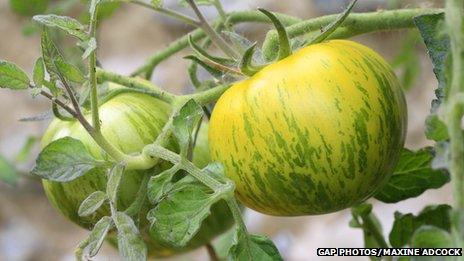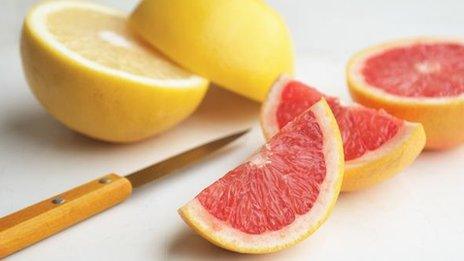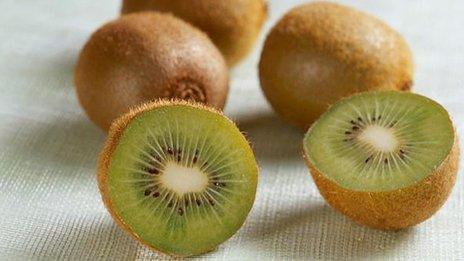Are we sacrificing taste for looks and availability?
- Published

The sweet flavour of tomatoes has been accidentally bred out of mass-produced varieties that ripen at the same time, scientists have found. But in order to be able to buy "perfect" produce year-round, are consumers missing out on something else?
"I happen to like green tomatoes, when they are ripe, like green zebra, (which has a) beautiful flavour," says Chris Smith of Pennard Plants, a nursery in Somerset.
But he says most people do not like them, "because people eat with their eyes".
"You look at a green tomato and then in your own mind it's not ripe - and so therefore you don't think it has the flavour," Mr Smith says.
Consumers typically "match more rounded forms... with sweet tastes", according to research in Flavour journal, and it is this inbuilt predilection for buying ripe fruit and vegetables that has helped shape the global fresh produce markets, where crops are harvested and stored weeks ahead of their sale in shops.
The UK's homegrown fruit and vegetable market is worth £1.8bn, according to the Department for Environment, Food and Rural Affairs (Defra), but its figures show vegetables worth £1.9bn (excluding mushrooms and potatoes) and fruit worth £2.4bn are also imported each year.
In order to achieve large-quantity crops that ripen simultaneously, certain varieties have become exceedingly popular with growers, to the detriment of others.
In the US, more than 15m tonnes of tomatoes are harvested each year. US researchers have found that the breeding process to produce tomatoes that can be harvested at the same time and turn an even shade of red, has inadvertently <link> <caption>turned off a key gene during photosynthesis which produces sugars in commercial varieties</caption> <url href="http://www.telegraph.co.uk/science/science-news/9362122/Breeding-tomatoes-for-best-colour-ruins-taste.html" platform="highweb"/> </link> .

Grapefruit should be picked after flowering, and stored at 10C for optimal taste
This reduction in sugar "compromises the flavour", the study in the journal Science found.
"Now that we know, some of the qualities that people value in heirloom tomatoes can be made available in other types of tomatoes, farmers can have access to more varieties... that produce well and and also have desirable colour and flavour traits," says lead author Ann Powell, a biochemist from the University of California, Davis.
Heirloom fruit and veg varieties are celebrated by gardeners as having strong, distinctive flavours.
They had been forced to the margins in recent decades by EU rules, like the introduction of an expensive seed registration process. But last year rules were relaxed, and Victorian varieties are once again being grown.
"It didn't matter if the skins were thin, it didn't matter if the plants were large, or the fruit was large or not regular shaped - they (the Victorians) were worried about the flavour and not anything else," says Chris Smith.
Some supermarkets are now selling heritage tomatoes "as taste is becoming much more of an issue" says Tom Sharples from Dobie Seeds in Devon.
However the EU still dictates the size and shape of produce that can be sold, and for some, their look doesn't quite fit.
Tom Sharples says skins still need to be thicker for transportation to avoid bruising, and so major producers have breeding programmes under way to develop the perfect hybrid.
But it's not just flavour and looks that consumers are concerned with.
One recent study in Appetite journal found the second most important factor in purchasing specific fresh produce like cherries was shelf life, after price.
Tom Sharples says: "The home gardener just wants the taste, and of course a reasonable yield, and the supermarkets want the shelf life."
To get it right, scientific studies in to the time fruit and vegetables should be put in to cold storage are needed.
Research in to the cold storage of avocados found nutritional compounds and antioxidant activity in early harvested fruit that had been in storage for 35 days was much higher than it was in late harvested fruit stored for 21 days.
It concluded that avocados could be harvested earlier for economic benefits without losing nutritional value.

Kiwifruit can be cold-stored for six months after harvesting
However a study of grapefruit harvesting shows the date they are picked has a clear influence on decay, with 30.7% of fruit picked before flowering rotting, but only 5.5% rotting if picked during full bloom.
It concluded growers should harvest grapefruit after flowering, but not too late, and to store them at 10C (50F).
Meanwhile, the difference of a week in harvesting time for kiwi-fruit stored for six months had a clear difference on their nutritional value.
Vitamin C and carotenoids were higher in fruits gathered first, but these were reduced after six months in cold storage. However fruits harvested a week later actually seemed to "improve their quality after a long storage".
Tom Sharples agrees the scientific techniques that have been developed, like pre-chilling on the fields can maintain more vitamins.
"If you take something like spinach for instance, you can lose 70% of vitamins within seven hours of harvest," he says.
While science remains focused on commercial crops, gardeners hope there we will soon see more old varieties crossed with modern hybrids, that have the flavour but are more disease resistant.
Because as Chris Smith says: "We are now so worried about the transportation of fruit and vegetables... they are not bred for flavour anymore."
- Published3 May 2012
- Published12 March 2012
- Published9 March 2011